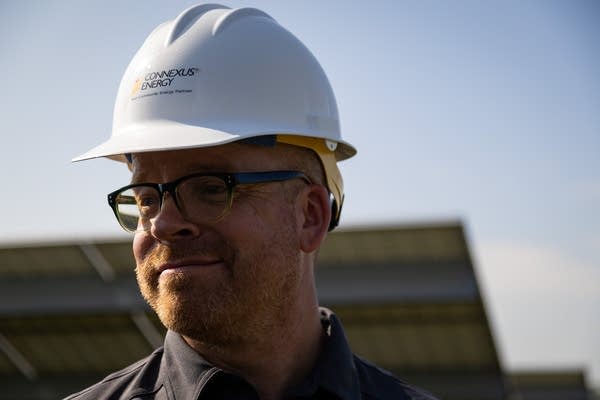Listening to the birds and the bees to make solar farms more biofriendly

Go Deeper.
Create an account or log in to save stories.
Like this?
Thanks for liking this story! We have added it to a list of your favorite stories.
Researchers are using listening devices and cameras at three Minnesota solar farms to learn how planting native grasses and flowers benefits birds, bees and other wildlife.
Argonne National Laboratory, an Illinois-based research center funded by the U.S. Department of Energy, has been collecting data at solar farms owned by Enel Green Power in Mankato and Atwater since 2018. A solar-and-battery facility owned by Connexus Energy in Ramsey was added in 2020.
Using microphones and motion-activated cameras, Argonne researchers are tracking visits by birds and wildlife to measure biodiversity at each solar farm.
“We're trying to get data from all different kinds of sites that have planted different seed mixes, or some that haven't really planted at all, that just have grasses growing on the site,” said Heidi Hartmann, program manager of land resources and energy policy at Argonne.
Turn Up Your Support
MPR News helps you turn down the noise and build shared understanding. Turn up your support for this public resource and keep trusted journalism accessible to all.
The data they gather could help federal officials develop better practices for managing vegetation on solar farms to provide ecological benefits, as Minnesota and the U.S. shift away from fossil fuels to cleaner sources of energy.
The Department of Energy estimates at least 10 million acres of solar production will be needed across the U.S. by 2050 to achieve zero-carbon goals.
“If we can do it in a way that also benefits the environment, that's going to be key,” Hartmann said.

Tracking birds, bees and other critters
Argonne researchers visit each site every two weeks throughout July and August. They follow 100-foot lines called transects, recording all blooming plants and pollinators that they see.
On a hot, sunny day in July, Hartmann hiked between long rows of solar panels at the Ramsey Renewable Station, pausing when a colorful flower or insect caught her eye.
“Oh, that's a beautiful bumblebee,” she said. The insect was perched on a spikey, purple flower called leadplant growing abundantly amid the solar arrays.
“There's quite a bit of it here, and apparently the bees like it,” Hartmann said.
At the far end of the row, Hartmann found what she was looking for: a tripod equipped with a motion-activated camera that captures images of any critters that happen to crawl, scurry or fly by.

“A lot of it is just blowing grass,” she said. “But you also get different kinds of wildlife. We've got raccoons and birds, of course, and we have seen deer on some of the sites.”
The tripod also holds an acoustic and ultrasonic device that records bird and bat calls for several hours a day around sunrise and sunset.
In one year, the microphones at the Ramsey station detected more than 47,000 bird calls from nearly two dozen different species, including sandhill cranes, goldfinches, robins, finches and an osprey. The data will be compared to recordings from a control site in a nearby farm field.
Hartmann said at one Wisconsin research location, monitors detected more bird visits at the control site, but a greater diversity of species at the solar farm.
“We're still trying to figure out the reasons for that,” she said. “It may be just better habitat on the solar sites. It may be some protection afforded by shade during the day, if it's hot.”

‘If you build it, will they come?’
The Ramsey solar farm used to be surrounded by farm fields. But nearby, rows of new houses have cropped up. Connexus Energy representative Rob Davis said they don't mind having neighbors.
“It's really exciting to be able to see that we're essentially providing them a free park for wildlife,” he said. “Folks can sit on their back deck and hear the bird songs and enjoy the monarchs that fly through.”
When Connexus proposed the solar-and-battery storage facility, which was built in 2018, some local residents resisted the idea. What helped change minds, Davis said, was explaining the benefits of native prairie plants and flowers to the soil and nearby farm crops that depend on pollinators.
“It was because of that additional ground cover quality that gave (us) the thumbs up for this project to proceed,” he said.

Planting pollinator habitat was about the same cost as putting gravel under the solar panels, said Greg Ridderbusch, Connexus president and CEO.
“It just seemed to us to be a better practice,” he said. “Over the years, we've standardized it. We think if you're going to take some land and use it for solar production, the pollinator plantings upgrade the soil over time.”
Argonne expects to release some preliminary data soon, and publish its findings in about a year. If they show solar farms can have a positive impact on biodiversity, that could help them become more widely accepted by communities across the U.S., said Lee Walston, an ecologist at Argonne.
“It's to answer the question — if you build it, will they come?” Walston said. “If you build solar facilities that are habitat friendly, what kinds of biodiversity responses do you see or hear as a result?”
Argonne wants to see more solar companies plant diverse mixes of seeds that include deep-rooted flowering plants, Hartmann said. Along with attracting bees and butterflies, they help hold the soil in place, prevent erosion and control flooding, she said.
“There's more upfront cost, maybe, to establish the nice, healthy vegetation on the site,” Hartmann said. “But we believe it pays off.”




